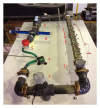Microbial fuel cells for direct electrical energy recovery from urban wastewaters
- PMID: 24453885
- PMCID: PMC3881690
- DOI: 10.1155/2013/634738
Microbial fuel cells for direct electrical energy recovery from urban wastewaters
Abstract
Application of microbial fuel cells (MFCs) to wastewater treatment for direct recovery of electric energy appears to provide a potentially attractive alternative to traditional treatment processes, in an optic of costs reduction, and tapping of sustainable energy sources that characterizes current trends in technology. This work focuses on a laboratory-scale, air-cathode, and single-chamber MFC, with internal volume of 6.9 L, operating in batch mode. The MFC was fed with different types of substrates. This study evaluates the MFC behaviour, in terms of organic matter removal efficiency, which reached 86% (on average) with a hydraulic retention time of 150 hours. The MFC produced an average power density of 13.2 mW/m(3), with a Coulombic efficiency ranging from 0.8 to 1.9%. The amount of data collected allowed an accurate analysis of the repeatability of MFC electrochemical behaviour, with regards to both COD removal kinetics and electric energy production.
Figures





Similar articles
-
Scaled-up multi-anode shared cathode microbial fuel cell for simultaneous treatment of multiple real wastewaters and power generation.Chemosphere. 2022 Jul;299:134401. doi: 10.1016/j.chemosphere.2022.134401. Epub 2022 Mar 23. Chemosphere. 2022. PMID: 35339526
-
Pilot scale microbial fuel cells using air cathodes for producing electricity while treating wastewater.Water Res. 2022 May 15;215:118208. doi: 10.1016/j.watres.2022.118208. Epub 2022 Feb 17. Water Res. 2022. PMID: 35255425
-
Industrial wastewater treatment with a bioelectrochemical process: assessment of depuration efficiency and energy production.Water Sci Technol. 2018 Jan;77(1-2):134-144. doi: 10.2166/wst.2017.532. Water Sci Technol. 2018. PMID: 29339612
-
Practical energy harvesting for microbial fuel cells: a review.Environ Sci Technol. 2015 Mar 17;49(6):3267-77. doi: 10.1021/es5047765. Epub 2015 Feb 24. Environ Sci Technol. 2015. PMID: 25670167 Review.
-
Microbial electro deionization for waste water treatment - A critical review on methods, applications and mechanism.Environ Res. 2022 Nov;214(Pt 3):113999. doi: 10.1016/j.envres.2022.113999. Epub 2022 Aug 4. Environ Res. 2022. PMID: 35932837 Review.
Cited by
-
Bioelectromics of a photosynthetic microalgae assisted microbial fuel cell for wastewater treatment and value added production.Sci Rep. 2025 Aug 18;15(1):30196. doi: 10.1038/s41598-025-13271-1. Sci Rep. 2025. PMID: 40825794 Free PMC article.
-
Simple Yeast-Direct Catalytic Fuel Cell Bio-Device: Analytical Results and Energetic Properties.Biosensors (Basel). 2021 Feb 11;11(2):45. doi: 10.3390/bios11020045. Biosensors (Basel). 2021. PMID: 33670116 Free PMC article.
-
Microbial Fuel Cells as Effective Tools for Energy Recovery and Antibiotic Detection in Water and Food.Micromachines (Basel). 2023 Nov 22;14(12):2137. doi: 10.3390/mi14122137. Micromachines (Basel). 2023. PMID: 38138306 Free PMC article.
-
Electrospun Nanofibers: from Food to Energy by Engineered Electrodes in Microbial Fuel Cells.Nanomaterials (Basel). 2020 Mar 14;10(3):523. doi: 10.3390/nano10030523. Nanomaterials (Basel). 2020. PMID: 32183252 Free PMC article.
-
Carbon Nanofiber Double Active Layer and Co-Incorporation as New Anode Modification Strategies for Power-Enhanced Microbial Fuel Cells.Polymers (Basel). 2022 Apr 11;14(8):1542. doi: 10.3390/polym14081542. Polymers (Basel). 2022. PMID: 35458291 Free PMC article.
References
-
- Potter MC. Electrical effects accompanying the decomposition of organic compounds. Proceedings of the Royal Society B. 1911;84:260–276.
-
- Rabaey K, Verstraete W. Microbial fuel cells: novel biotechnology for energy generation. Trends in Biotechnology. 2005;23(6):291–298. - PubMed
-
- Kim BH, Park DH, Shin PK, Chang IS, Kim HJ. Mediator-less biofuel cell. US Patent 5976719, 1999.
-
- Chang IS, Jang JK, Gil GC, et al. Continuous determination of biochemical oxygen demand using microbial fuel cell type biosensor. Biosensors and Bioelectronics. 2004;19(6):607–613. - PubMed
-
- Shantaram A, Beyenal H, Raajan R, Veluchamy A, Lewandowski Z. Wireless sensors powered by microbial fuel cells. Environmental Science & Technology. 2005;39(13):5037–5042. - PubMed
MeSH terms
Substances
LinkOut - more resources
Full Text Sources
Other Literature Sources

